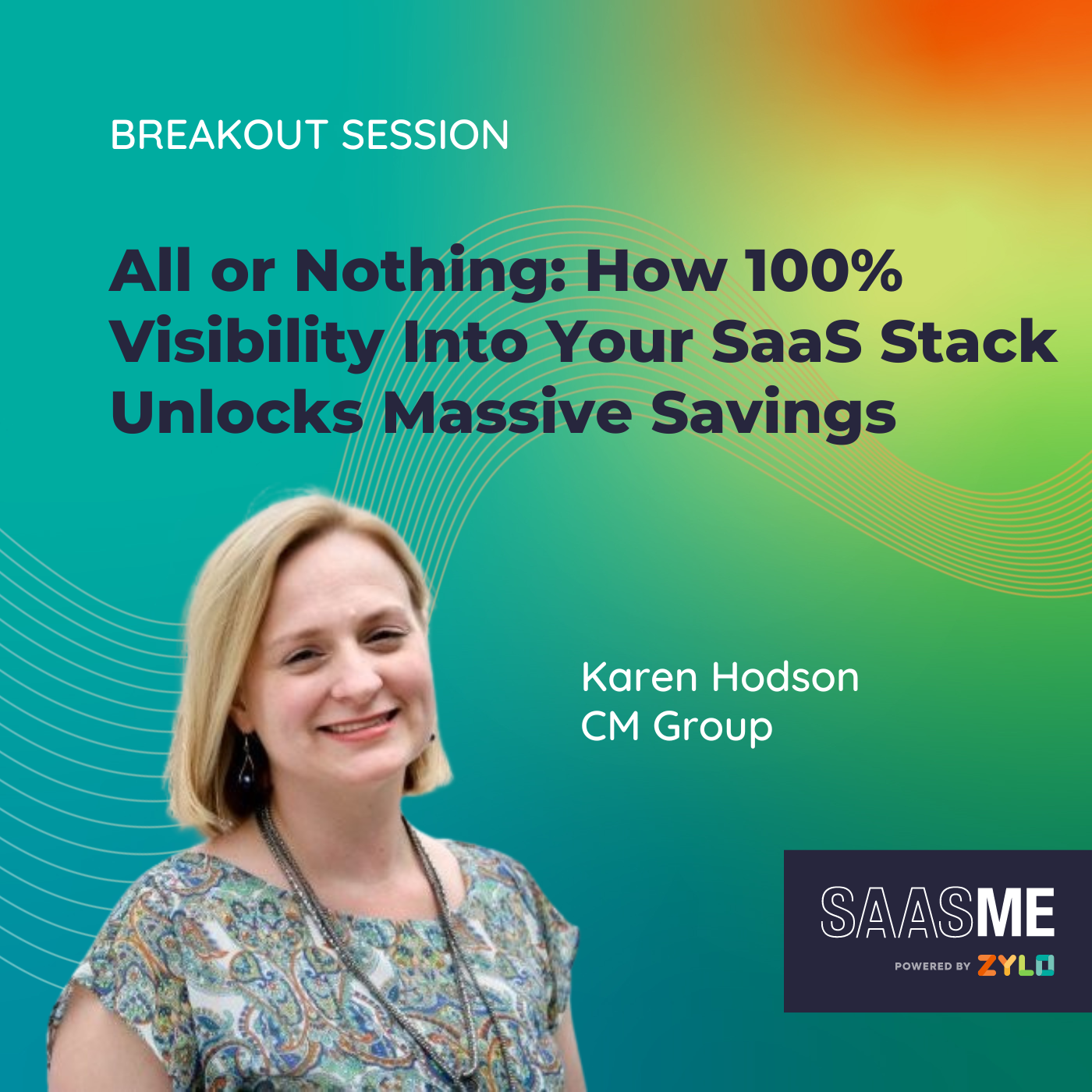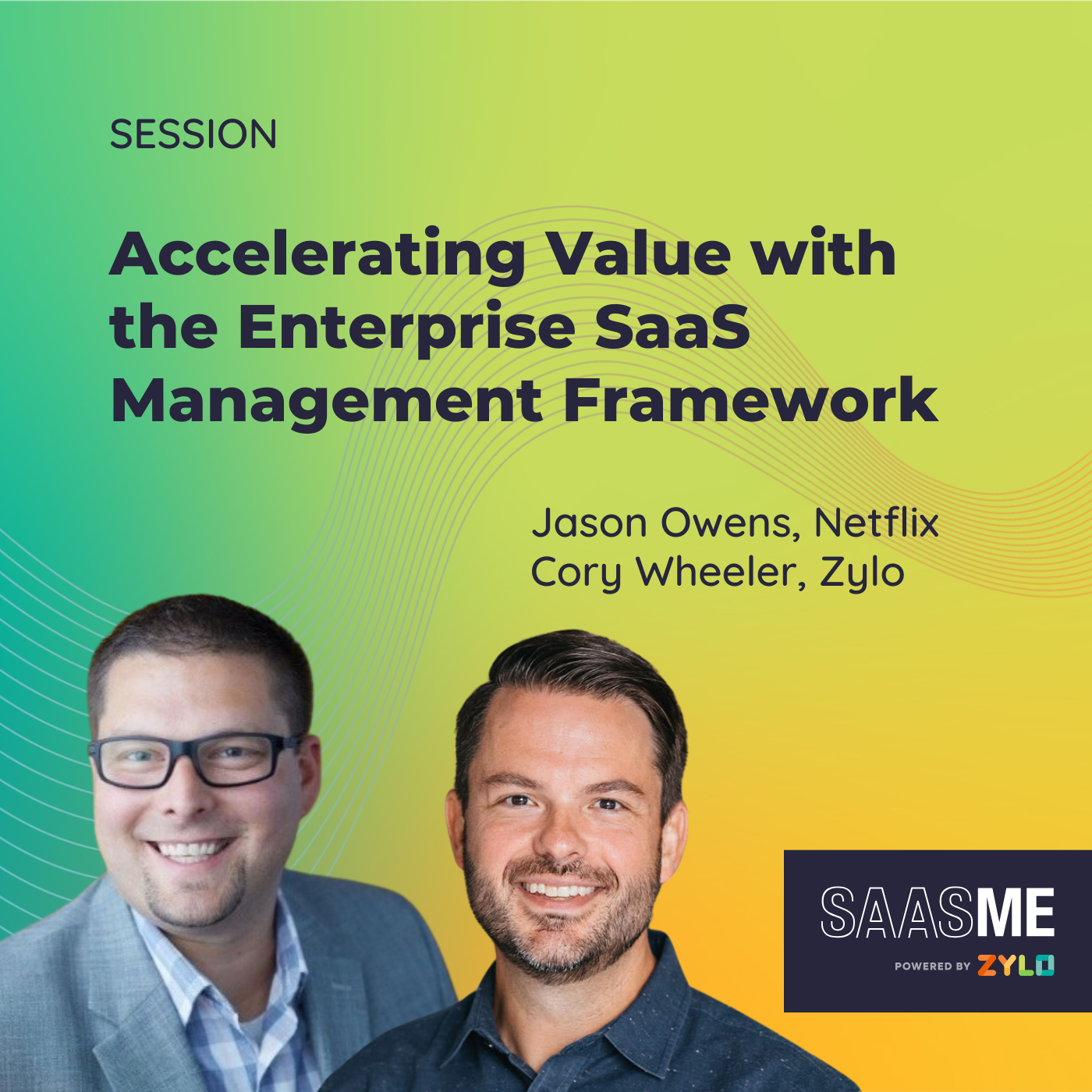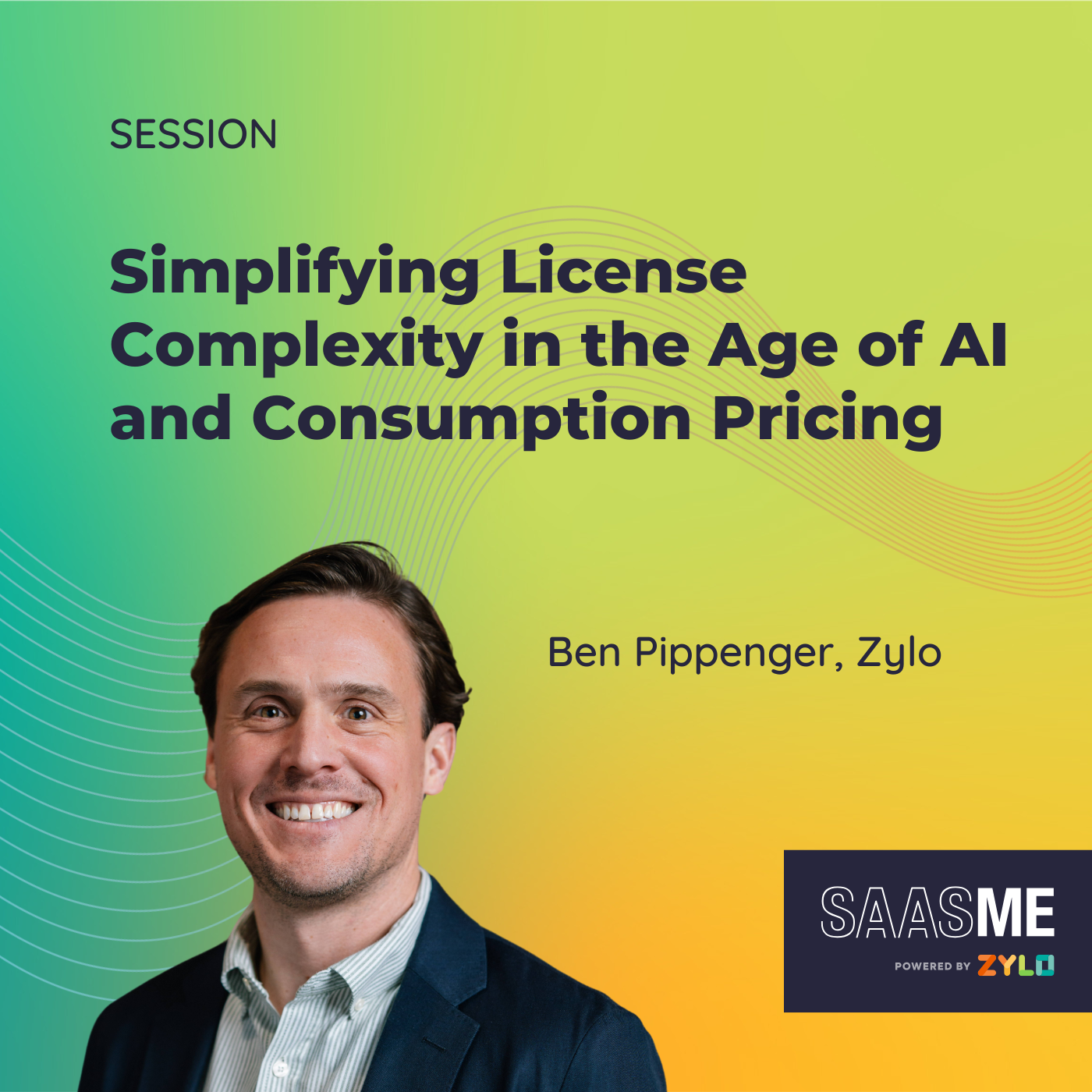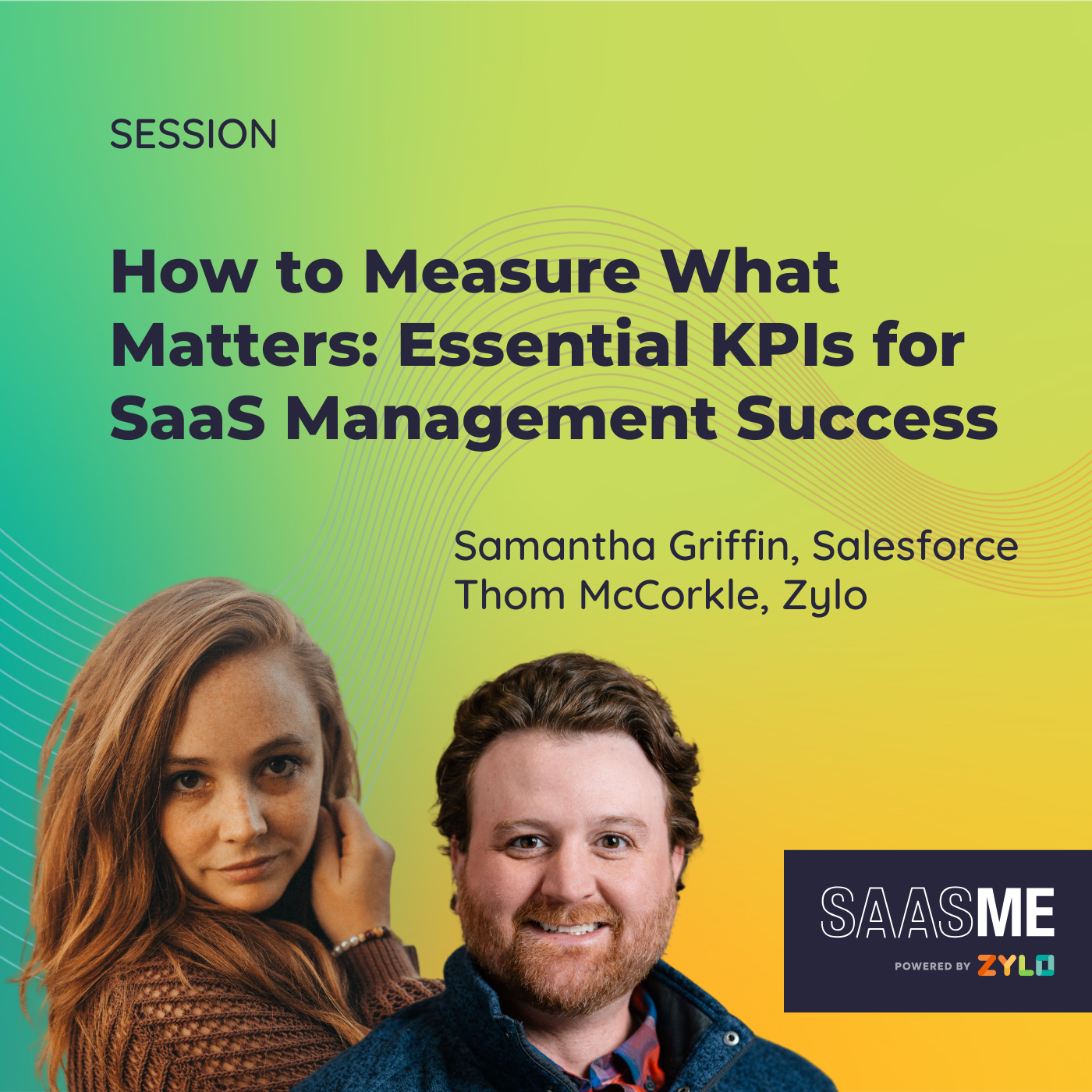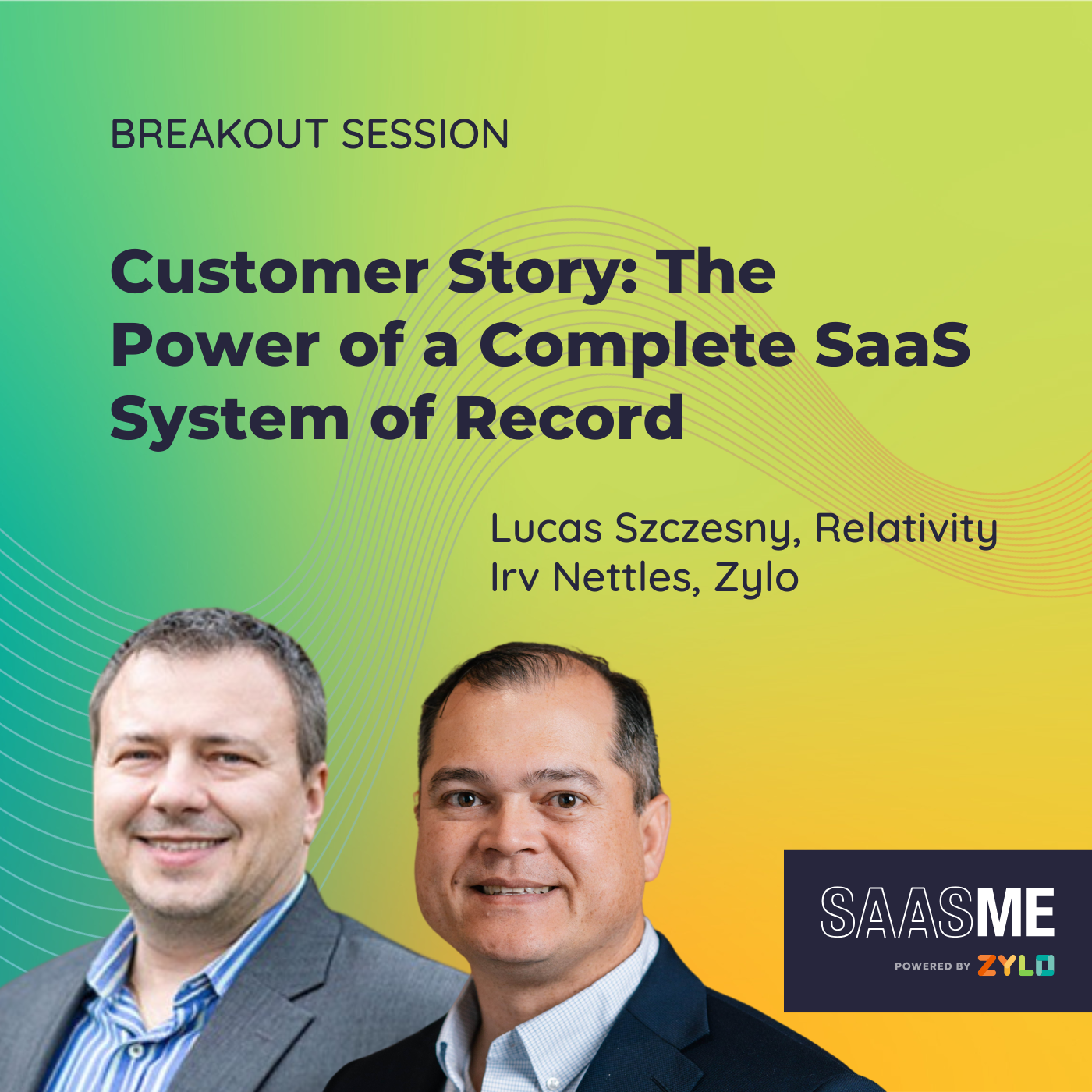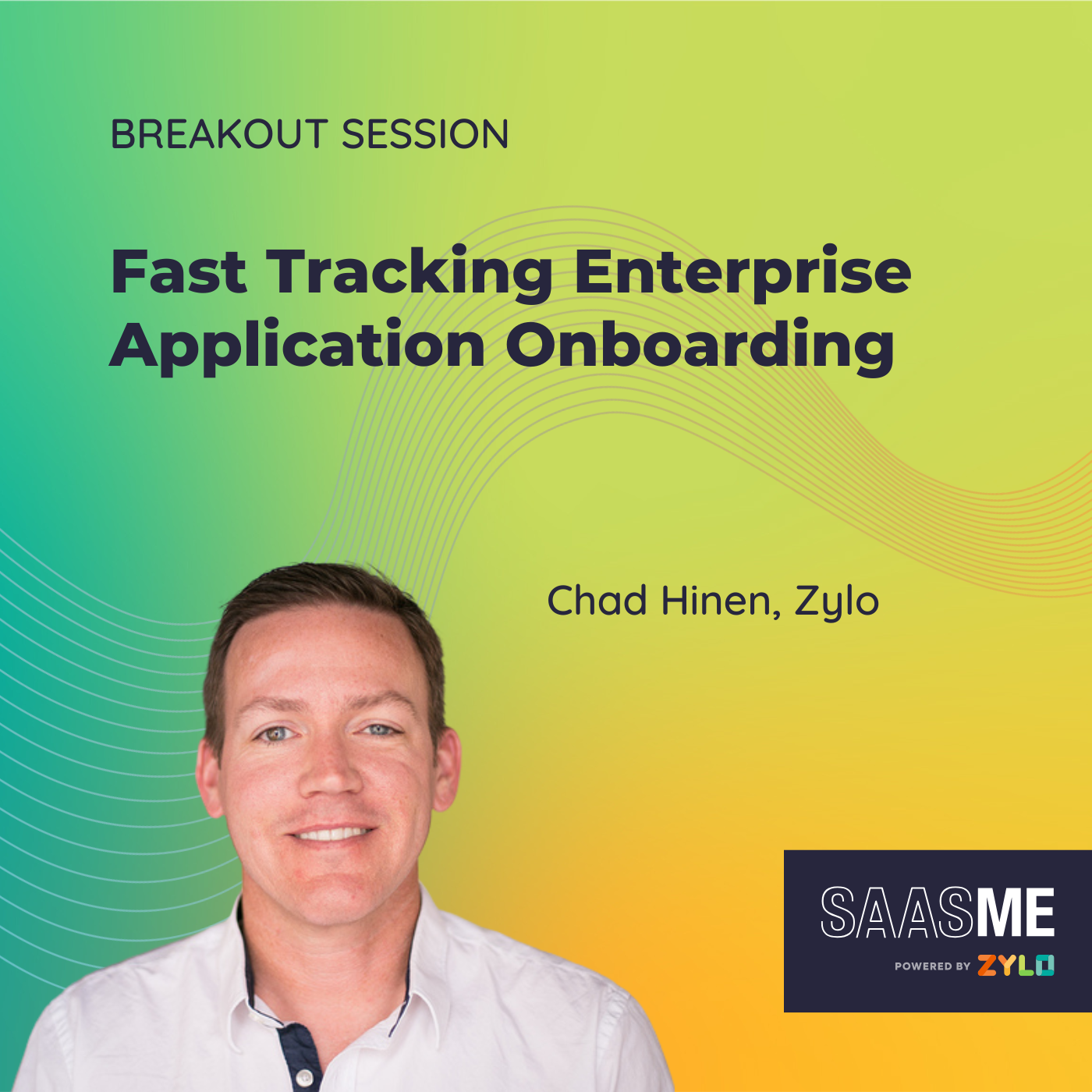All or Nothing: How 100% Visibility Into Your SaaS Stack Unlocks Massive Savings
- 0.5
- 1
- 1.25
- 1.5
- 1.75
- 2
Ashley Hickman: Okay, looks like we have a nice little crowd here. So let's go ahead and get kicked off for the breakout session. Going to make sure that our session is, that we can keep moving along. We have some more great content, but really excited to spend a little bit of time with you all as well as Karen Hodson today. So for anyone who I haven't already had the opportunity to meet, I see some customers here in the session and some people that I haven't had the pleasure of meeting yet. I'm joined today by Karen Hodson, who is the Global Procurement and Real Estate Officer at Campaign Monitor Group, CM Group. And I am Ashley Hickman. I'm the manager of Customer Success at Zylo. Today's session, we're going to be doing a little bit of all or nothing. How 100% visibility into your SaaS stack unlocks massive savings. And we're going to be chatting about that here with Karen. Karen, if you could introduce yourself. I know I kind of gave you a little bit of an intro, but would love for you to introduce yourself, and chat a little bit about your role at CM Group.
Karen Hodson: Karen Hodson, Global Procurement and Real Estate Officer for CM Group. We are a global company, a little under 2000 employees. We probably have employees located in just about every country, almost every continent, so all time zones. I've been with the company just shy of six years now. And in that time period we have merged nine different companies together. So we have had to try to figure out where all of our spend is going, everywhere. And with regard to managing procurement, we manage all engagements with vendors, whether it's$ 0 or a million dollars. So the amount of money spent with a vendor doesn't really matter, in our view, procurement is still responsible for those that are even a$ 0. That's a key distinction I think.
Ashley Hickman: Awesome. So a tremendous amount of breadth and depth it sounds like in your day to day. Really would like to set the stage today with pre Zylo. A lot of people are in this situation where they have really the problem of SaaS management, how they're going to get a handle on their applications, et cetera. You're now a Zylo customer. We have a pleasure working with you. But would love to hear for myself as well as for people joining today's session, how were you approaching SaaS management pre Zylo? What were you really looking to solve for? How did you uncover it? Would love to hear a little bit about that pre Zylo journey and then go from there.
Karen Hodson: I think that the answer anybody would probably give is that it's called spreadsheet, spreadsheet, spreadsheets. And we all try to capture everything we can within a spreadsheet. So part of it is saying, Hey, finance team who have we paid money to? Which is great except for the$ 0 ones, that doesn't help me capture those ones. So then it's also, hey IT team, what tools are you aware of and are there any connected to Okta or what do you guys have knowledge about? And just really trying to piecemeal together all of the understanding of purchases across the organization and then looking at those and going, well, is that a SaaS tool or is that some other kind of tool? So then we also have to distinguish is it a SaaS tool and figure that piece out. So it's a lot of pulling information together, big spreadsheet and trying to add information and figure out what's going on and who owns it in the company, so that we can get some background. The challenge is, inevitably, the moment you create those spreadsheets, they become outdated. It's always trying to update and keep them current is a challenge. And then when we do a lot of M& A activity, then that just kind of blows up every spreadsheet that you have, because now you have this whole new bucket coming in. Outdated spreadsheets is pretty much the only way we could figure out how to get our head around what was going on with our SaaS spend, so we very quickly were trying to find a tool out there that to help us do that.
Ashley Hickman: Nice. And in terms of that problem, in terms of why that visibility was so important, especially in your procurement role, would love to hear a little bit more about that.
Karen Hodson: Sure. I mean look, people can come to us and we can be reactive," Oh, I want to buy this." Or," Hey, I want to renew this." Okay cool, let me look into it. We'll go from there. But it's very narrowed focus. You're looking at that one request that's coming from whatever department. You're not looking at holistically in the organization. Well, what if we are already buying that tool or we're buying a similar tool or hey, has somebody else asked for something like this that we could bring everyone together? What have we historically paid for this kind of tool? Maybe we've had one, got rid of it. Why did we get rid of it? Things like that. So it's very narrow focus if you don't have that visibility from an organizational standpoint, of course you can always handle one- off requests and deal with the things in the moment and renewals, but you're only able to deal with that very narrowed bit of information. So having a tool like Zylo gives you that holistic view of comparison of, well, are you already spending money on the same similar type tool? If so, how much are you spending? Who's the owner of that? Let's take a look and do a deeper dive there. And then also benchmarking information when you're trying to expand.
Ashley Hickman: Awesome. We've covered that pre Zylo state, that kind of living in spreadsheets and to your point, having a narrow focus and being very reactive. So now that you have that visibility, with Zylo, would love to hear about what the experience is now. How it's shifted, those conversations, those reactive conversations, if and how those have changed now that you have that at your fingertips?
Karen Hodson: We've got two ways that we've been able to really be more proactive. We have the whole M& A activity, which I think is a bit separate so I'm going to talk about both. But really it's, now I can see visibility of what are we buying, how much are we spending, how many licenses do we have? If we're able to connect, either via Okta for actual user information of when was the last time somebody logged in into this tool? if I had bought 100 licenses to something, how many of those licenses are being utilized? What's underutilized? Especially when you come to renewal discussions. Can we get rid of some licenses? Do we have the right licenses? Through Okta connections or Direct Connects that Zylo has with different tools out there like Salesforce and Asana and other software tools so that we can have even deeper visibility beyond a hey, this is what we buy and this is how much we pay. Well, this is how many licenses we've had and this is the utilization on those licenses. Having that information then allows us to actually have these discussions about renewals, well in advance. We're talking 90 days or more, I recommend, no less than three months. Because really getting people to have a conversation and focus outside of their day to day job on something like this, you want to give them enough time. When you get yourself ahead to have discussions about renewals that are upcoming, you're being more proactive. Saying," Hey, take a look at this."" Hey, it doesn't look like we need as many licenses as before." Or maybe we don't need this tool at all because you have very low utilization. What's going on? Or we can say," Hey, you know what? We have this one that's coming up but we also have a similar tool the organization buys, maybe this is the opportunity to drop off of this one and add to that one and reduce the number of vendors and tools that we're managing because they're similar or the same." It allows us to have those conversations, it allows us to track what departments own these tools and who within those departments own them so that we're reaching out appropriately in the business. We also, for our organization, like to have monthly cadence calls with the different departments to discuss, hey, this is what's coming up in the next 90, 120, however many days. This stuff's coming down the line. Do we want to talk about any of this that we see further down? Because maybe there's been changes or decisions made already even though we still got six months. No reason to not have the conversation sooner. So this data has allowed us to have more meaningful conversations with the tool owners and the department owners about renewals and about merging tools together and have data to back that up. On the M&A activity side, you can imagine, now we have this whole new set of information that comes in. We actually have two instances of Zylo because very often when you first do some M&A, your finance systems are separated, those things aren't pushed together yet, but we want to start taking action right away. So having a second instance of Zylo allows us connect to their finance systems and pull in that data, and then we're doing an instant compare of what tools are the exact same. Do they buy Asana and we buy Asana? Do they buy Slack and we buy Slack? Now we're going to be one. How do we bring those together and seeing what that spend is like and that information, so all of the same tools. Then, we can start comparing with all the tools where there's overlapping, things like that. So really getting that instant visibility to the new company that has now come into an organization or the two separate and how we bring them together and figure out the right path forward as a single company. Having that data to back it up and have those conversations and to really deep dive into, hey you guys have, maybe you have Asana and we have Teamwork. Well, they're both project management type tools. Maybe, do we bring them together? Is there a reason to have both? Have those conversations and really dive into it. So that's been beyond helpful because getting visibility into purchasing when you're doing M&A activity is very challenging, tracking down the contracts. Last thing I want to do is ask for a spreadsheet of information, so Zylo allows it. And really with our company, we are a SaaS company ourselves, and I would say probably 85% of the things we buy are SaaS tools. So Zylo is a tool that helps give us a lot of visibility into our spend because the mass majority of our spend is SaaS. I think it will help any company, if you buy any kind of SaaS, which I don't think you could run a business without SaaS, so there is this value, but if you're buying a lot of SaaS to run your business, then the value of Zylo increases exponentially, I think.
Ashley Hickman: Awesome. That's really, really helpful. So one thing I want to mention before we keep going, Karen, if anyone has any questions or anything like that, definitely feel free to use the chat or the Q& A feature. Karen and I are happy to take those as they come, so just definitely feel free if you have any questions along the way. But, trying to get back to things, Karen, a lot of people today, especially people who are often in the sessions, we have a lot of different breakouts, so we know people are in the same boat today, where some people may have a SaaS management tools, some people are in that pre- phase. So in terms of based off of where they're at in their journey, their level of maturity, et cetera, you certainly are one of our more mature customers. You have a process down pat for M&A, for how you're managing your SaaS, but truly a program today. So some of those tips and tricks, how they can get started into getting 100% visibility into SaaS and taking action.
Karen Hodson: I think that if you don't already have a tool like Zylo, or that kind of instant visibility into your SaaS spend, and you have any M& A activity on the horizon, the M& A activity and the information that you will get through a tool like Zylo basically instantly pays for itself. And the amount of time that you would spend trying to track this stuff down, basically we always say pulling back the curtain or lifting the hood, once you close on a deal, you have so much visibility before you finalize a M& A activity, the deal is done, and then now we all have to actually look under the covers and actually really see what is there and we get the truth behind everything and we all try to figure out, okay, well we both knew we had these tools but, oh they have a pro version and we have an enterprise version and so what does that mean? Do we downgrade or do we upgrade? And where's the true path forward and getting that information. I think if you have any M& A activity along, coming down the pike, I think you should immediately invest in a tool like this, because otherwise you're going to spend so much time tracking down information. But even so, just having a tool to give you visibility and guidelines on how to move forward. I think one thing that our team is really proud of is that we have probably a. 01% of what you would call maverick spend, or unknown spend that pops up that somebody in the company maybe bought software and expensed it. We have very little of that. Now one, that's our own internal policies where we don't allow that. But also using Zylo, it gives us that instant visibility and have somebody might have done that, maybe they didn't realize, we immediately reach out and say," Hey by the way we see that you expensed this. Let's have a conversation. We actually have a corporate account with this tool, no reason to be doing an individual account." So it allows us to really control that spend a lot better and have that visibility because we have Zylo connected to our net suite and connected to our Expensify, so we know all the spend that's going out the door. And even the$ 0, even if it's popping for, because we are connected via Okta. That allows us to know, oh we're using this tool. Yeah, there's no dollars being spent but these people are logging into this tool and we know that because of Okta. So there's other ways to track down what's happening and why it's happening. And also Zylo's giving us those reminders of all the spend renewals that are coming up, what's coming up in the horizon in the next 30, 60, 90, 120 days. Is it a big spend? What's going on? And allows us that time to deep dive. We've created plans of how we have meetings with those departments every month and have those conversations. But you can also run reports and have those reports going out and having, maybe it's whoever owns Salesforce, that they are on a regular basis going into Zylo and deep diving into the license usage. Because it's not a cheap tool, you want to make sure that you have the right license types for the different people, that kind of thing. Data is king. Everybody's said that for years, so having data that you can rely on is really important. I can have spreadsheets all day long, but inevitably there's human error. People are going to maybe add the wrong number to a box or forget a line or those kinds of things. Now, you can have spreadsheets to try to remind you of things and follow up, but who owns that spreadsheet? Who created that spreadsheet? Sometimes the knowledge of how that was structured goes out the door when they might leave the organization, so the reliability of that information just dwindles over time. Whereas a tool like Zylo connecting in real time to your finance systems and then connecting in real time to your Okta, and direct connects to the different tools that you're buying has a lot more reliability on that data. So when you're having conversations, you actually have something to back up," Hey, you don't need this many licenses. I'm saying that because I can tell you right now, half the people haven't logged in more than 90 days into this tool. So let's reevaluate it." And you have the information to back it up instead of it just being a," You guys tell me how many licenses you need. Oh okay, you need more. Cool. Let's go buy it," without knowledge of what has the utilization been of those licenses in the past.
Ashley Hickman: Absolutely. Absolutely. I know that's something that a lot of people struggle with and Kyle, see that in the chat. I have the pleasure of working with Kyle myself and yes, the team tab is a great way to tag those repeat expense violators. I know that's something that, when you mentioned, Karen, maverick spend that y'all do a really a great job of minimizing it and keeping at bay. That can be a big challenge, really a shift. It's change management to get people to stop expensing software and then manage that on an ongoing basis.
Karen Hodson: Absolutely.
Ashley Hickman: Absolutely. So one thing, because you're in... And you and I, we've had conversations before, so would love to hear your view and really have your view shared with the people who are joining us today around procurement role within the organization. You have this visibility that our platform is providing you. In terms of how you're leveraging that visibility within procurement within the rest of the organization, would love to hear a little bit more about that for myself and everyone joining us today.
Karen Hodson: I think that it's really important for any organization, in my opinion, to have procurement and have that procurement be a centralized department. Meaning that, we don't belong to any single department. I don't sit under marketing team and we don't sit under any particular department. And our goal really is to break down the silos between all of those departments, because when you're buying for the organization, you really need to have the overarching view of spend for the company. Somebody from sales team comes and says," Hey, we want to buy this cool tool called X, Y, Z." We're like," Oh, that's amazing. Hey actually I see what this tool does, and marketing was talking about doing something similar or marketing brought up that exact same tool. How about we have a conversation with those departments and we start pushing those people to come together and speak." What we really do is we break down the walls. We are really the conversation starters in the organization around being respectful and responsible with how we're spending the company's money and what tools we're engaging for the organization and how best to leverage those tools, whether it's a single department utilizes it or multi departments can utilize that, to get the best value out of it. So our job is really having those conversations. We have that thousand foot view of an organization's spend. We know all the vendors that we're engaging with. We help have those conversations, reduce and consolidate tools, usage and spend. It's all about talking. So if you're not into having conversations and talking, then procurement probably isn't for you.
Ashley Hickman: No, I love that. Did you get music in your earbuds for a second?
Karen Hodson: No.
Ashley Hickman: No. That's weird. Okay. I don't know why that's happening. But anyway, we actually had a question in the Q&A so we're going to go ahead and jump to that, which I love. I'm just going to read this off here, Karen. I love the idea you mentioned about monthly meetings with other departments. Can you talk about that a little more? What do you cover? Do you give other departments access to Zylo or provide them data from Zylo?
Karen Hodson: I had been on a call with somebody and they had this great idea, and we always talk about procurement, we want to get a seat at the table. I really have to write down who I stole this from because it's not mine. But I love their idea of, how about we just create the table and invite them instead? So instead of trying to get invited to the table, you be the table. I pushed that with my team and that's what we do. We have procurement meetings with each of the departments on a monthly basis, to go through what's coming up. Now, what we do is we pull a lot of reports out of Zylo, especially if there's a particular SaaS tool that's coming up in the next 90 or so days that we are going to have that first talk about, we will pull information from Zylo about usage and even those discussions, these days it's all in Zoom, we'll screen share and say," Hey, let's take a look. In Zylo, here's your users for this tool and this is what we're looking at." And we can deep dive into that specific item that we might be talking about. But typically we started out with an overview of all of their purchases, and you can see the spend across the entire calendar year, and then we focus very much so on the next 30, 60, and 90 days that are coming up. And sometimes those conversations are quick because we've been on top of a lot of them a lot of it's just a really catch up on what's happening and then we start going," Okay and hey, let's go to that 120 day mark, what's now coming?" And start pushing it further down the line and having those conversations even further. But yeah, we start with that list of, this is what's coming up in the certain timeframe, let's have those conversations. This particular tool, let's deep dive on it. And we utilize Zylo to deep dive in there. With giving access to Zylo, we have pretty much anybody in the finance team and the FP& A team, so those that are building out budgets, they all have full access. And then there's certain groups that we allow access to dive in. Department heads can dive into that information.
Ashley Hickman: Awesome. That's a great question and I love the idea, to your point, instead of waiting to be invited, to go ahead and build your own table, create your own table and get things to start happening. Love that. Let's see, any other questions from anyone on the line? Feel free to add them in the chat or the Q&A. I know we're coming close to time here, but want to make sure that we take advantage of the last few minutes here before we go back to the main stage where the next session is going to be starting here in a few minutes. So if there is any, or Karen, even if you just have any closing thoughts for anyone on the line, anyone who's struggling with getting full visibility or now that they have visibility, because that's another big thing that people will struggle with is they have the full visibility and now it's kind of like what to do with it. Think that idea of creating the table, inviting departments, sharing the data, having those conversations, that's absolutely some takeaways for people on the line.
Karen Hodson: Yeah, sure. Of course. I think that when you finally first have that initial visibility, it's a lot of information. You finally now have all of this data. I think what we have done in the past, is we will sort the vendors by top spend. Attack the big ones. Take a look immediately at those large spend ones. What can you do for any of them? Is there some impact and change that you can make immediately? Take a look at the top 10, then look at the top 20, 25 and start building it down. Obviously, if there's any repetitive type tools being used, that's a good one to attack. But really look at the top spend. That's where you're going to have the most immediate impact. Take a look at that. And then over time, obviously, the goal is to get through it all and consolidate through everything. And if you're lucky and have a team that you can have others help get through that information and take action, do that. My suggestion is to take that information and start at the top that spend and see what you can do to fix that.
Ashley Hickman: Love that. That's definitely something that I know that a lot of the SaaS consultants saying that's the way, the best way you can slay dragons, certainly. And also make the most impact, starting with with the large question there. I know we're actually going to be heading back to the main stage, so first and foremost, Karen, it's been a pleasure speaking with you today. Thank you so much for joining us. Very excited on the Zylo side that we get to continue our partnership with you and keep partnering with the CM Group and yourself moving forward. So thank you all. Thank you all for joining us. And Karen, thank you so much for your time today.
Karen Hodson: Thank you so much. Always a pleasure to be with you.
DESCRIPTION
You can’t manage what you can’t see. Effective SaaS Management starts with getting full visibility into your SaaS footprint. Hear Karen Hodson, Global Procurement & Real Estate Officer at CM Group, share how she’s been able to drive visibility into SaaS and take action on her learnings to drive massive savings.
Today's Guests


